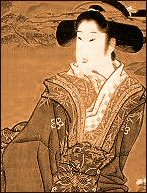
|
|
Birth
Took place in private, in order to 'save face' should the child not
survive. The mother adopted a squat position, being supported on either
side by two kneeling women. The baby was not bathed nor clothed for
some seven days after birth. Woman and child were considered taboo
until thirty one days (for a boy) or thirty three days (for a girl),
had elapsed. Then, after a visit to a Shinto
shrine, all taboos were lifted and the father could approach his wife.
The first born was always favoured, served first with food etc. |
Childhood
The first birthday was considered most important and was an occasion
of great joy. 'Babyhood' lasted until the age of seven for boys, six
for girls. At this time boys were able to wear hakama
and girls real kimonos. Both sexes played and slept together, usually
in the same room as their parents (for 'common folk'), there was therefore
an early initiation into sexual matters, people had no inhibitions
regarding sex. Nobles, would usually entrust their children to monasteries
for their education. A system of adoption, yoshi,
was practised by nobles to give them suitable heirs.
The Shogun's permission was required for
a samurai to adopt a child. |
Coming of age
Children 'came of age' at around thirteen, (fifteen for a boy of samurai
class). The ceremony of 'coming of age' was called, Gempuku.
At this time, a boy of samurai class would have his hair arranged
in a coil on the top of his head and he would be permitted to wear
an eboshi, a man's head dress. He could
now also carry, and use, a real sword. Girls of noble class had their
eyebrows shaved and their teeth blackened (custom of the Heian
court). |
Love
To begin a romance, the suitor would make himself known to the lady
by sending a suitable poem. The poem would be either self composed
or taken from a book of 'ready-made' efforts.
A love affair took place in semi darkness with the woman at first
hiding behind her screen, kicho. After
a 'successful' night the lover would leave at dawn and later that
day would send another poem. Great care would be taken in producing
this 'next day' poem, often selecting an item of natural beauty to
add to the communication (such as a sprig of willow). She would, hopefully,
respond in a suitably creative fashion. |
 |
Marriage
Usually arranged by the parents. The marriage rite consisted of the
exchange of three cups of sake (each drank three sips), this was called
sansankudo.
Divorce could be accomplished by a woman with the act of 'running
away'. This required the woman to live for two years at a particular
temple, safe from unwanted attention.
Polygamy was common with the aristocracy during the Heian
and early Kamakura periods. Wives were
expected to be faithful to their husbands while their husbands often
'roamed', this was generally accepted. |
|


